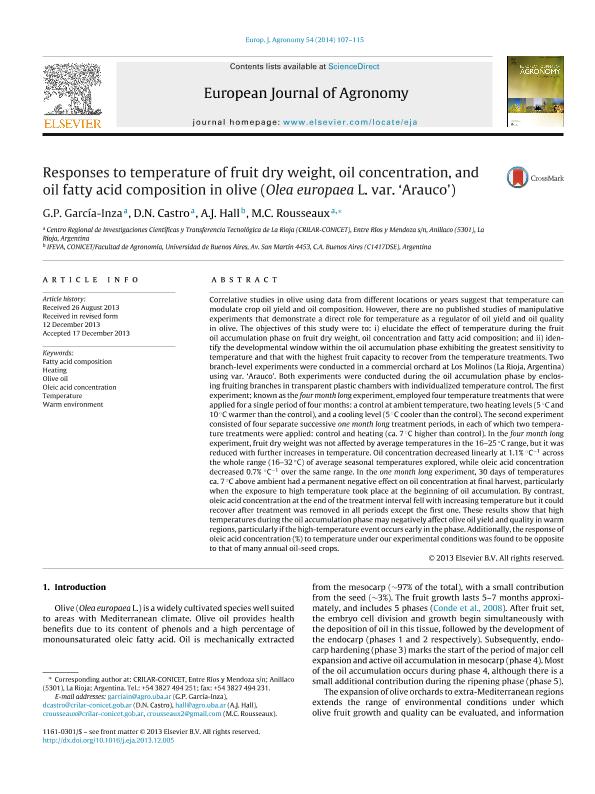Artículo
Responses to temperature of fruit dry weight, oil concentration, and oil fatty acid composition in olive (Olea europaea L. var. 'Arauco')
Fecha de publicación:
03/2014
Editorial:
Elsevier Science
Revista:
European Journal of Agronomy
ISSN:
1161-0301
Idioma:
Inglés
Tipo de recurso:
Artículo publicado
Clasificación temática:
Resumen
Correlative studies in olive using data from different locations or years suggest that temperature can modulate crop oil yield and oil composition. However, there are no published studies of manipulative experiments that demonstrate a direct role for temperature as a regulator of oil yield and oil quality in olive. The objectives of this study were to: i) elucidate the effect of temperature during the fruit oil accumulation phase on fruit dry weight, oil concentration and fatty acid composition; and ii) identify the developmental window within the oil accumulation phase exhibiting the greatest sensitivity to temperature and that with the highest fruit capacity to recover from the temperature treatments. Two branch-level experiments were conducted in a commercial orchard at Los Molinos (La Rioja, Argentina) using var. ‘Arauco’. Both experiments were conducted during the oil accumulation phase by enclosing fruiting branches in transparent plastic chambers with individualized temperature control. The first experiment; known as the four month long experiment, employed four temperature treatments that were applied for a single period of four months: a control at ambient temperature, two heating levels (5 °C and 10 °C warmer than the control), and a cooling level (5 °C cooler than the control). The second experiment consisted of four separate successive one month long treatment periods, in each of which two temperature treatments were applied: control and heating (ca. 7 °C higher than control). In the four month long experiment, fruit dry weight was not affected by average temperatures in the 16–25 °C range, but it was reduced with further increases in temperature. Oil concentration decreased linearly at 1.1% °C−1 across the whole range (16–32 °C) of average seasonal temperatures explored, while oleic acid concentration decreased 0.7% °C−1 over the same range. In the one month long experiment, 30 days of temperatures ca. 7 °C above ambient had a permanent negative effect on oil concentration at final harvest, particularly when the exposure to high temperature took place at the beginning of oil accumulation. By contrast, oleic acid concentration at the end of the treatment interval fell with increasing temperature but it could recover after treatment was removed in all periods except the first one. These results show that high temperatures during the oil accumulation phase may negatively affect olive oil yield and quality in warm regions, particularly if the high-temperature event occurs early in the phase. Additionally, the response of oleic acid concentration (%) to temperature under our experimental conditions was found to be opposite to that of many annual oil-seed crops.
Archivos asociados
Licencia
Identificadores
Colecciones
Articulos(CRILAR)
Articulos de CENTRO REGIONAL DE INV. CIENTIFICAS Y TRANSFERENCIA TECNOLOGICA DE ANILLACO
Articulos de CENTRO REGIONAL DE INV. CIENTIFICAS Y TRANSFERENCIA TECNOLOGICA DE ANILLACO
Citación
García Inza, Georgina Paula; Castro, Diego Nicolas; Hall, Antonio Juan; Rousseaux, Maria Cecilia; Responses to temperature of fruit dry weight, oil concentration, and oil fatty acid composition in olive (Olea europaea L. var. 'Arauco'); Elsevier Science; European Journal of Agronomy; 54; 3-2014; 107-115
Compartir
Altmétricas




